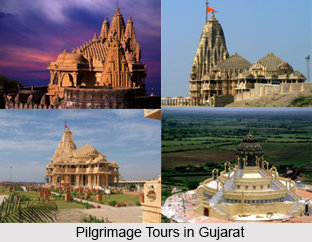 This state is an important pilgrimage center for Hindus. Gujarat is dotted with temples and mosques. One of the major pilgrimage centers in Gujarat is Dwarka. This place is located 137 kilometers West of Jamnagar. It was a flourishing port in ancient times and a famed holy spot. According to Hindu mythology Lord Krishna established Dwarka 5,000 years ago. The Temple of Dwarkadish on the northern bank of the Gomti Creek is typical of the architecture of ancient Hindu temples. It has a shrine, a large hall, a roof supported by 60 columns of granite and sandstone and a conical spire, which is almost 160 feet high. This holy place has 7 floors. Its exterior is profusely carved while the inside is extremely simple. The shrine is richly decorated and has a sculpted figure of Lord Ganesha at the entrance. The place has been further beautified by 5 sweet water springs across the creek of salt water.
This state is an important pilgrimage center for Hindus. Gujarat is dotted with temples and mosques. One of the major pilgrimage centers in Gujarat is Dwarka. This place is located 137 kilometers West of Jamnagar. It was a flourishing port in ancient times and a famed holy spot. According to Hindu mythology Lord Krishna established Dwarka 5,000 years ago. The Temple of Dwarkadish on the northern bank of the Gomti Creek is typical of the architecture of ancient Hindu temples. It has a shrine, a large hall, a roof supported by 60 columns of granite and sandstone and a conical spire, which is almost 160 feet high. This holy place has 7 floors. Its exterior is profusely carved while the inside is extremely simple. The shrine is richly decorated and has a sculpted figure of Lord Ganesha at the entrance. The place has been further beautified by 5 sweet water springs across the creek of salt water.
The Sun Temple at Modhera is a 3-hour journey by road in north of Ahmedabad. It is one of the finest examples of Indian architecture. Built in 1026, during the reign of King Bhima of the Solanki dynasty, it is dedicated to the Sun God. The shrine stands on a plinth overlooking a deep stone-stepped tank. It has been elaborately carved with figures of gods, flowers and animals.
While driving along the coastal roads through Chorwad and Verawal it will lead one to
Somnath, one of the most sacred Shiva temples in India. It stands majestically along the Arabian Sea. It had been ransacked repeatedly by northern invaders and rebuilt over and over, successively in gold, silver, wood and finally in stone. According to legends ithe temple had been built by Somu, the Moon God, in penance and worship of the wrathful Lord Shiva who had laid a curse on him. In 1026 much of the temple was destroyed by Mohammed Ghazni and parts of the present temple have been reconstructed in the old style. Apart from its historical and religious interest it is also famous for the temple that had been constructed on the spot where Lord Krishna is said to have been accidentally killed by a hunter`s arrow. Rhythmic cymbals clash at dusk to mark the time for special prayers.
Akshardham has been constructed on a 23-acre plot at Gandhinagar district and is dedicated to Lord Swaminarayan. It is built in pink sandstone and stands tall at a height of 108 feet. It is said that 6000 tonnes of stone has gone into its making. This is one of the edifices that had been built as per the rules of Vastu Shastra. One of the main features of this shrine is that steel had not been used at all for constructing this temple.
Palitana is also known as the temple city. It is located in Bhavanagar district and is famous worldwide as a Jain Pilgrimage center. At a distance of two kilometers from the town is the Shatrunjay Hill, the most important centre of Jain pilgrimage, with an incredible 863 Jain temples atop its twin peaks. Palitana is also a major marketing centre for chillies, cereals and pulses and has a bustling market for farmers.
Ambaji in Banaskantha district is a temple that is dedicated to Ambe Mata. This is also a popular pilgrimage center. During Navratri it is receives a lot of devotees. It is situated on the Arasur hill in the Aravali Range. The striking feature of the temple is that it does not contain any idol. It has only consists of a `yantra` engraved in a niche. The entire temple has been built out of marble.
The Indo-Saracen architecture of Ahmedabad blends Hindu and Muslim styles. Sidi Saiyad`s Mosque near Relief Road is Ahmedabad`s most eloquent example of this kind of work in sandstone. Its twin windows of pierced stone flaunt a design of a tree with palm leaves and curving tendrils. This is a must see. The shaking minarets of Rajpur Bibi`s Mosque at Gomtipur and Sidi Bashir`s Mosque at Kalipur are also worth visiting. The main attraction of these mosques is that if pressure exerted on the inner walls of the minarets it sets them vibrating.



















